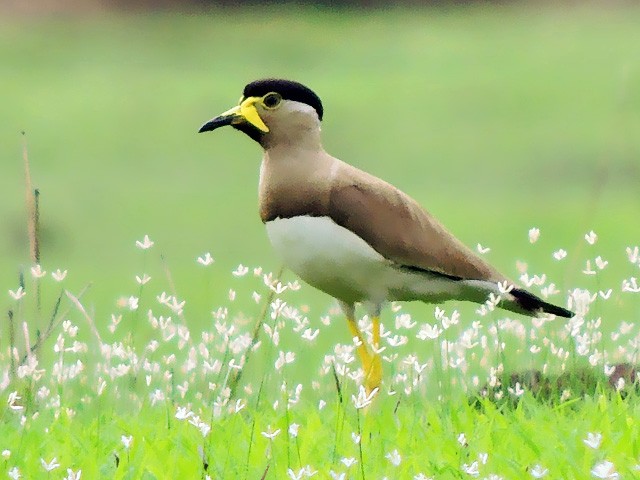Yellow-wattled Lapwing
A species of Lapwings Scientific name : Vanellus malabaricus Genus : Lapwings
Yellow-wattled Lapwing, A species of Lapwings
Botanical name: Vanellus malabaricus
Genus: Lapwings
Content
Description General Info
 Photo By Shantanu Kuveskar , used under CC-BY-SA-4.0 /Cropped and compressed from original
Photo By Shantanu Kuveskar , used under CC-BY-SA-4.0 /Cropped and compressed from original Description
These are conspicuous and unmistakable birds found in dry stony and open grassland or scrub habitats. They are medium-sized pale brown waders with a black crown which is separated from the brown on the neck by a narrow white band and large yellow facial wattles. The chin and throat are black and the brown neck and upper breast is separated from the white belly by a narrow blackish line. The tail has a subterminal black band which does not extend into the outer tail-feathers. There is a white wingbar on the inner half of the wing. The bill is yellow at the base. They have tiny yellow carpal spurs. The crown feathers can be raised slightly in displays. They are mostly sedentary but populations make long distance movements in response to the monsoons. They are occasional visitors to the Kathmandu valley in Nepal and a vagrant was seen in Malaysia. There are no recognized subspecies, but there is a size increase from south to north. They are 260-280mm long with a wing of 192-211mm, bill 23-26mm, tarsus 57-66mm and tail 71-84mm. Juveniles have a brown crown and the sexes are alike but males have slightly longer wings and tarsi. The call is a sharp tchee-it call. Local names include zirdi in Hindi, chitawa in Telugu and jithiri in Rajasthan and Pakistan, pili tatihri in Punjabi, laori in Madhya Pradesh, parasna titodi or vagdau titodi in Gujarati, pitmukhi titvi in Marathi, manjakanni in Malayalam, haladi tittibha in Kannada, aalkati in Tamil and kiraluwa in Sinhalese. 
Size
28 cm
Nest Placement
Ground
Feeding Habits
Yellow-wattled Lapwing predominantly consumes insects like grasshoppers and beetles, along with their larvae and molluscs. Notably, yellow-wattled Lapwing forages primarily at night, showcasing nocturnal feeding behavior.
Habitat
The yellow-wattled Lapwing typically resides in open and dry lowland habitats across broad geographic regions including the Indian subcontinent. Preferring drier environs than its close relative, this species occupies areas such as cultivated fields, fallow lands, and diverse wastelands. While it may be observed at the fringes of wetland ecosystems, proximity to water is not a necessity for the yellow-wattled Lapwing, marking a distinction in habitat selection compared to Vanellus indicus. Seasonal movements are influenced by rainfall patterns, though these migrations are not fully understood.
Dite type
Insectivorous
General Info
Feeding Habits
Bird food type
Behavior
These lapwings breed in the dry season with peak breeding in March to May ahead of the monsoons. The nest territory has been estimated, based on the distance to nearest neighbours, to be about 2.7 acres. They lay four eggs in a ground scrape. A nest in a clump of grass has been noted as exceptional. Parents visit water and wet their breast feathers ("belly soaking"; they may stay for as much as 10 minutes to soak water ) which may then be used to cool the eggs or chicks. The four eggs typically hatch simultaneously, even though they are laid with a difference of a few days. The nidifugous young are well camouflaged as they forage with the parents. Chicks squat flat on the ground and freeze when parents emit an alarm call. A second brood may be raised, particularly when the first fails and young from a previous brood have been seen along with parent birds incubating a second clutch. Simultaneous courtship displays among several pairs in close proximity has been noted. In one study more than 60% of the nests had 4 eggs-clutches with the rest having 3 eggs. Hatching success was found to be about 27.58% and egg loss was due to predation and nest damage. The incubation period was 27–30 days. When the nests are approached, the incubating bird attempts to move away from the nest without drawing attention to it. The food of the yellow-wattled lapwing is beetles, termites and other invertebrates, which are picked from the ground. The feather mite Magimelia dolichosikya has been noted as an ectoparasite of this species. 
Distribution Area
This species is common in much of India, being seen in a variety of open lowland habitats. It tends to be seen in drier habitats than the red-wattled lapwing, Vanellus indicus. They are found in most parts of India, parts of Pakistan, Nepal, Bangladesh and Sri Lanka. They make short distance movements in response to rain but the exact pattern is not known. 
Species Status
Not globally threatened.
Scientific Classification
Phylum
Chordates Class
Birds Order
Shorebirds Family
Plovers Genus
Lapwings Species
Yellow-wattled Lapwing